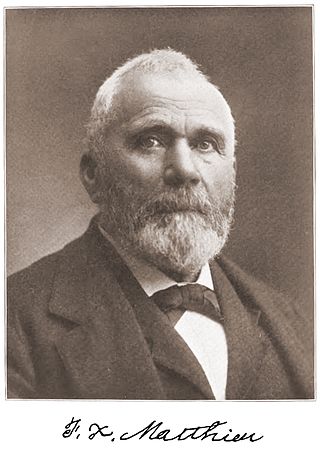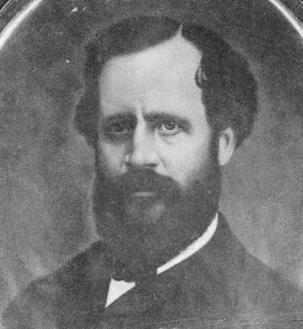Related Research Articles

Butteville is a census-designated place and unincorporated community in Marion County, Oregon, United States. For statistical purposes, the United States Census Bureau has defined Butteville as a census-designated place (CDP). The census definition of the area may not precisely correspond to local understanding of the area with the same name. As of the 2020 census the population was 273. It is part of the Salem Metropolitan Statistical Area.

A mountain man is an explorer who lives in the wilderness and makes his living from hunting and trapping. Mountain men were most common in the North American Rocky Mountains from about 1810 through to the 1880s. They were instrumental in opening up the various emigrant trails allowing Americans in the east to settle the new territories of the far west by organized wagon trains traveling over roads explored and in many cases, physically improved by the mountain men and the big fur companies, originally to serve the mule train-based inland fur trade.

Oregon Country was a large region of the Pacific Northwest of North America that was subject to a long dispute between the United Kingdom and the United States in the early 19th century. The boundaries of the area, which had been created by the Treaty of 1818 without recognizing indigenous claims to the area, consisted of the land north of 42° N latitude, south of 54°40′ N latitude, and west of the Rocky Mountains down to the Pacific Ocean and east to the Continental Divide. Article III of the 1818 treaty gave joint control to both nations for ten years, allowed land to be claimed, and guaranteed free navigation to all mercantile trade. However, both countries disputed the terms of the international treaty. Oregon Country was the American name while the British used Columbia District for the region. Meanwhile, Indigenous nations had lived in the area since time immemorial, though with little legal recognition in the American and British legal systems. Evidence along the Salmon River shows people lived there at least 16,000 years ago, and may have populated the continent after migrating along the Pacific Coast, then following up the Columbia River into the interior.

Champoeg is a former town in the U.S. state of Oregon. Now a ghost town, it was an important settlement in the Willamette Valley in the early 1840s. Located halfway between Oregon City and Salem, it was the site of the first provisional government of the Oregon Country.

George Washington Bush was an American pioneer and one of the first African-American non-Amerindian settlers of the Pacific Northwest.

The Champoeg Meetings were the first attempts at formal governance by European-American and French Canadian pioneers in the Oregon Country on the Pacific Northwest coast of North America. Between 1841 and 1843, a series of public councils was held at Champoeg, a settlement on the French Prairie of the Willamette River valley in present-day Marion County, Oregon, and at surrounding settlements. The meetings were organized by newly arrived settlers as well as Protestant missionaries from the Methodist Mission and Catholic Jesuit priests from Canada.
The history of immigration to Canada details the movement of people to modern-day Canada. The modern Canadian legal regime was founded in 1867, but Canada also has legal and cultural continuity with French and British colonies in North America that go back to the 17th century, and during the colonial era, immigration was a major political and economic issue with Britain and France competing to fill their colonies with loyal settlers. Until then, the land that now makes up Canada was inhabited by many distinct Indigenous peoples for thousands of years. Indigenous peoples contributed significantly to the culture and economy of the early European colonies to which was added several waves of European immigration. More recently, the source of migrants to Canada has shifted away from Europe and towards Asia and Africa. Canada's cultural identity has evolved constantly in tandem with changes in immigration patterns.

The Sager orphans were the children of Henry and Naomi Sager. In April 1844 the Sager family took part in the great westward migration and started their journey along the Oregon Trail. During it, both Henry and Naomi died and left their seven children orphaned. Later adopted by Marcus and Narcissa Whitman, missionaries in what is now Washington, they were orphaned a second time, when both their new parents, as well as brothers John and Francis Sager, were killed during the Whitman massacre in November 1847. About 1860 Catherine, the oldest daughter, wrote a first-hand account of their journey across the plains and their life with the Whitmans. Today it is regarded as one of the most authentic accounts of the American westward migration.

Comcomly (1765–1830) was a Native American leader of the Lower Chinook, a group of Chinookan peoples indigenous to the Pacific Northwest, who inhabited the area near Ilwaco, Washington. Concomly spoke Lower Chinook and was known for his skill with diplomacy and trade.
Joseph Gervais was a French-Canadian, later American, pioneer settler and trapper in the Pacific Northwest. He is the namesake for the town of Gervais, Oregon.

François "Francis" Xavier Matthieu was a French Canadian pioneer settler of the Oregon Country. He was educated in American values by a radical schoolteacher. Matthieu became involved in the 1837–1838 armed rebellion against British rule in Canada, for which he was forced to flee his native Quebec for safety in the United States, where he worked as a carpenter and a fur trader.

Peter Grant Stewart was a jeweler and pioneer of the Oregon Country in what later became the U.S. states of Oregon and Washington. A native of New York state, he traveled the Oregon Trail to the Willamette Valley and settled first in Oregon City and later in what became Washington. He was served on the Second Executive Committee of the Provisional Government of Oregon, and his homesite became part of Fort Canby at the mouth of the Columbia River.

The Provisional Government of Oregon was a popularly elected settler government created in the Oregon Country, in the Pacific Northwest region of North America. Its formation had been advanced at the Champoeg Meetings since February 17, 1841, and it existed from May 2, 1843 until March 3, 1849, and provided a legal system and a common defense amongst the mostly American pioneers settling an area then inhabited by the many Indigenous Nations. Much of the region's geography and many of the Natives were not known by people of European descent until several exploratory tours were authorized at the turn of the 18th and 19th centuries. The Organic Laws of Oregon were adopted in 1843 with its preamble stating that settlers only agreed to the laws "until such time as the United States of America extend their jurisdiction over us". According to a message from the government in 1844, the rising settler population was beginning to flourish among the "savages", who were "the chief obstruction to the entrance of civilization" in a land of "ignorance and idolatry".

French Prairie is located in Marion County, Oregon, United States, in the Willamette Valley between the Willamette River and the Pudding River, north of Salem. It was named for some of the earliest settlers of that part of the Oregon Country, French Canadian/Métis people who were mostly former employees of the Hudson's Bay Company. "French Prairie" naming was first captured in writing in the early 1850s by a French Consul to California visiting Oregon. Pierre Charles Fournier de Saint-Amant referred to the area as "les prairies françaises". French Prairie is also known as an early Métis settlement in the Pacific Northwest history.

Étienne Lucier, né Lussier, was a French-Canadian fur trader active primarily in the Pacific Northwest. He was hired by John Jacob Astor's Pacific Fur Company and sent to the region to help establish Fort Astoria. Later he became a settler in the Willamette Valley. Lucier attended the Champoeg Meetings and was one of few French-Canadians or "Canadiens" to vote for the Provisional Government of Oregon, an American and Canadian civil authority for the valley. He is credited with becoming the first European descendant farmer within the modern state of Oregon.

George Kirby Gay was an English sailor and later settler in the Oregon Country. He was a member of the Willamette Cattle Company that brought livestock to Oregon and built the first brick house in the United States west of the Rocky Mountains. Gay also participated in the Champoeg Meetings that created a provisional government in what would become the U.S. state of Oregon.

Gazelle was an early sidewheeler on the Willamette River in what is now the U.S. state of Oregon. She did not operate long, suffering a catastrophic boiler explosion on April 8, 1854, less than a month after her trial voyage. This was the worst such explosion ever to occur in the Pacific Northwest states. The wrecked Gazelle was rebuilt and operated for a few years, first briefly as the unpowered barge Sarah Hoyt and then, with boilers installed, as the steamer Señorita. A victim of the explosion was D.P. Fuller, age 28, who is buried in Lone Fir Cemetery in Portland, Oregon.

Medorem Crawford was an American soldier and politician in what became the state of Oregon. A native of the state of New York, he emigrated to the Oregon Country in 1842 where he participated in the Champoeg Meetings and served in the resulting Provisional Government of Oregon as a legislator. A Republican, he later served in the Oregon House of Representatives after statehood and was appointed to several federal government offices. During the American Civil War he escorted emigrants over the Oregon Trail.
Pierre Chrysologue Pambrun was a French Canadian militia officer and later a fur trader in the service of the Hudson's Bay Company. Pambrun fought against the United States in the War of 1812, in particular the Battle of the Châteauguay. He joined the HBC during a time of turmoil with its competitors, the North West Company. After the Battle of Seven Oaks, he was among those held captive by men employed by the NWC.
French Settlement is the original name of Melrose, Oregon and its neighbouring valleys in Douglas County including Flournoy, Garden and Coles valleys. It is along the west side of the South Umpqua River South of its fork, a few miles West of Roseburg in Southern Oregon, West of Interstate 5. It roughly occupies a stretch of 8 miles by 4 miles of lush fertile well irrigated soil. The first American newcomers gave the location such a generic name based on the ethnicity or language spoken by the original settlers, namely French Canadians.
References
- ↑ Barman, Jean (2015-02-25). French Canadians, Furs, and Indigenous Women in the Making of the Pacific Northwest. UBC Press. pp. 131, 164, 224. ISBN 978-0-7748-2807-9.
- 1 2 3 McDonald, Lucile (1987). "The Pioneer Colbert Family of Ilwaco" (PDF). The Sou'wester. 22 (4). Archived from the original (PDF) on 2020-06-08. Retrieved 2020-06-08– via Pacific County Historical Society.
- ↑ "History of Historic Butteville". Butteville.org. Retrieved 2020-06-09.
- ↑ Clarke, S. A. (1905). Pioneer days of Oregon history. Allen County Public Library Genealogy Center. Portland, J. K. Gill company.